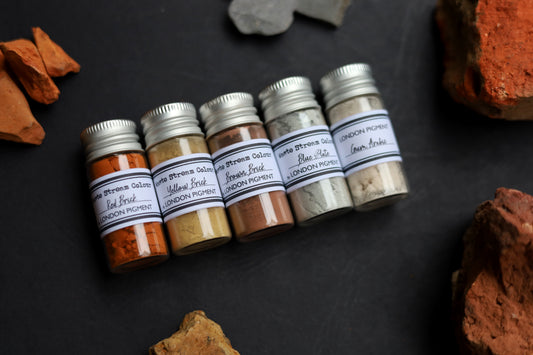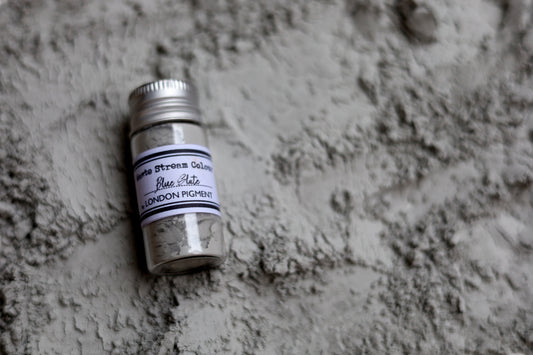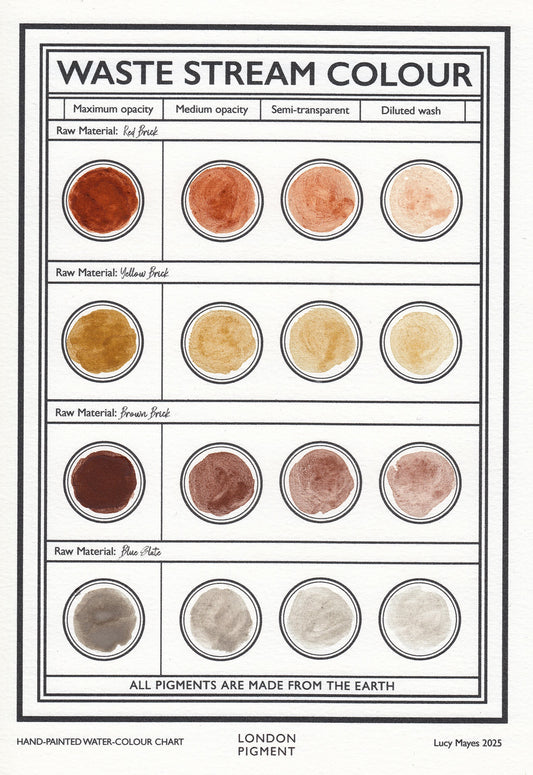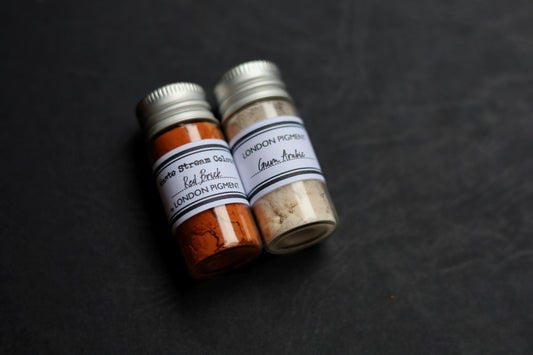Mayday Joyride 2020
Colour Palettes made from waste procured from vehicles

Watercolours made from metals procured from a broken moped and nearby plants. Displayed here as watercolours in Thames shells and paint swatches. These are used as teaching aids for workshops at The V&A and Royal Botanical Garden at Kew. Material collected from Rotherhithe, London, 2020.

Carbon black watercolour paints created from burnt rubber tyres and cherry gum, 2020.

Detail of watercolour painting made for the UCL publication that was made for the Colour & Poetry: A Symposium III, 2022. The paints were created from materials collected from a crashed moped in Rotherhithe, 2020. The shape of this colour chart is designed to allude to the brick wall that the moped was found next to, covered in burnt soot.
The following text was included in a publication produced by UCL, conceived and edited by Jo Volley with help from Lesley Sharpe.
Colour & Poetry: A Symposium III, 2022
Mayday Joyride, Rotherhithe, London 2020
London pigments are made of their name. They are made in London, they come from London, they are London.
On the 1st of May 2020, whilst walking in Rotherhithe, on the south-bank of the Thames. I stumbled upon the carcass of a burnt-out moped. Something about the act of a joyride, its wanton destruction, a feeling of the juvenile spirit of quick excess and a shot of short-lived pleasure, tugged at my own memories. The leap of your heart, the thrill of youth, an intense longing for nostalgia before anything has even begun.
My mind was whizzing with possibilities whilst my eyes darted between the moped’s newly transformed elements; from the black soot accumulating upon the brick wall of the underpass, and molten rubber tyres, to the white ash from the fire and the copper wiring that had somehow already gained a faint verdigris patina.
The 50s and 60s saw the flourishing of an American art movement around ‘happenings’ - events or performances that wore down the fourth wall between the performers and spectators. Evolving from Dada and surrealism, ‘happenings’ paved the way for modern performance art. The boundaries between art and life had begun to soften and were becoming a malleable film.
The reduction of a specific event, with all its details - noises, textures, differences in material, cause and effect - into a collection of colours, in essence extracts materials from one form of reality, and turns them into a uniform matter. Abstracted from their creation myth, in glass jars, these materials are devoid of meaning apart from the optical qualities that they evoke. Yet in reducing something to its purest form, a new kind of documentation arises.
Paint manufacturers have tried for hundreds of years to disconnect the artist from the truth of their materials. Pigments used by artists have been made from a whole manner of surprising and disparate materials - flowers, earth, rocks and beetles. Colours with specific provenance have been homogenised into paint ranges that use fillers and additives to mask the unique handling qualities of the pigments, so that painters do not need to think as much about these peculiar differences.
Another thrill: the infinite possibilities of a material. Anything can be repurposed, recycled and collaged in this world where distinct ‘newness’ is a human measurement. Perhaps newness could be the brush stroke of verdigris oil paint.

MayDay Joyride 2020: Carbon Black Pigment On Mirror From Crashed Moped 2020, Rotherhithe, London, 2020.

MayDay Joyride 2020: Carbon Black Pigment On Mirror From Crashed Moped 2020 (detail), Rotehrhithe, London, 2020.

MayDay Joyride 2020: A Selection of Processed Pigments, Watercolours, and Debris. Rotherhithe, London, 2020.
Waste Stream Colour Products
-
Waste Stream Watercolour Complete Set
Regular price From £70.00 GBPRegular priceUnit price per -
Blue Slate Pigment
Regular price £15.00 GBPRegular priceUnit price per -
Waste Stream Colour Chart
Regular price £15.00 GBPRegular priceUnit price per -
Waste Stream Watercolour Duo Set
Regular price £30.00 GBPRegular priceUnit price per



